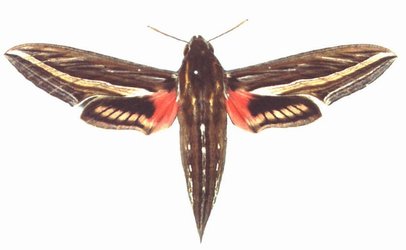Hippotion celerio
(Silver
striped hawkmoth)
Life
> Eukaryotes >
Opisthokonta >
Metazoa (animals) > Bilateria > Ecdysozoa >
Panarthropoda > Tritocerebra > Phylum:
Arthopoda > Mandibulata >
Atelocerata > Panhexapoda >
Hexapoda
> Insecta (insects) > Dicondyla > Pterygota >
Metapterygota > Neoptera > Eumetabola > Holometabola > Panorpida >
Amphiesmenoptera > Lepidoptera (moths
and butterflies) > Glossata > Coelolepida > Myoglossata > Neolepidoptera >
Heteroneura > Ditrysia >
Apoditrysia > Obtectomera >
Macrolepidoptera >
Bombycoidea > Family: Sphingidae (hawkmoths) >
Subfamily: Macroglossinae > Genus: Hippotion
 |
|
|
Hippotion celerio male [photo J. Joannou
©] |
|
Ecological interactions
Larval host plants in southern Africa
Information from Kroon (1999) unless otherwise
indicated.
-
Araceae
- Balsaminaceae
- Impatiens
spp. The host-plant records for this species are for
garden ornamentals but there are 4 indigenous species in southern Africa.
-
Fabaceae
-
Vitaceae
Pollination
Adults feed from a wide variety of long-tubed flowers
including:
-
Caricaceae
-
Carica papaya (Papaya, Papaw, Pawpaw). A cultivated species,
pollinated by hawkmoths, including Agrius convolvuli. Martins &
Johnson (2009) in a study conducted in rural Kenya, found that natural
habitats were important in sustaining hawkmoth populations because they
contained the larval hostplants needed in completing the life cycle. Hence,
papaya plants grown near natural habitats were more likely to be pollinated
than those isolated from natural habitats.
Links
Publications (by date)
- Kroon, D.M. 1999. Lepidoptera of Southern
Africa - Host-plants and other Associations. A Catalogue. Published by
the author and Lepidopterists' Society of Africa, P.O. Box 477, Jukskei Park
2153, South Africa.
- Martins DJ, Johnson SD. 2009. Distance and quality of
natural habitat influence hawkmoth pollination of cultivated
papaya. International Journal of Tropical Insect Science 29:
114-123.
http://dx.doi.org/10.1017/S1742758409990208
Text by Hamish Robertson
|
